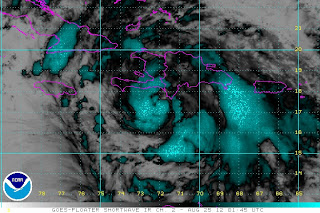 |
| Visible Image of Hurricane Issac near the Louisiana Coastline 7 PM August 28th |
In the last week, Tropical Storm Issac and then Hurricane Issac has impacted the vulnerable nation
of Haiti and then NOLA. In Haiti, there are at least 24 dead and thousands of homes have been damaged or destroyed. 5 persons in Dominican Republic also perished. The storm in the last few hours before hitting Haiti, accelerated and raced across the islands. Behind it were heavy rains that fell on a mostly deforested country. Grade for Haiti: D with poor procedures in place for more than 400,000 living in tents.
4 Days later on the anniversary of Hurricane Katrina, Issac sits off the coast of Louisiana not moving at all. On the day before making landfall Tropical Storm Issac finally became a hurricane. But unlike Haiti, there were mobs of TV stations trying to give every person in America the experience of being in a hurricane. Constant updates each hour analyzing the storm, its strength, projected track and possible impacts. Everyone said that New Orleans was ready for a category 1 storm, that would make its way in and out of the TV camera.
Of course, the storm was rolling right along on the projected track yesterday evening but once again, nature did not follow the TV schedule that had been planned. Just about 11 PM last night Hurricane Issac slowed down, wobbled west and stopped. It remained stationary most of the night. Tonight Issac has moved north, but is not far from where it was last night, with bands of heavy rain still pounding NOLA and areas to the east and north of the city. The levees were over-topped in Plaquemines Parish to the South and many people had to be rescued. Many blamed those stranded in Katrina on their lack of preparation or indifference to heeding the warning. The truth is that, hurricanes are a powerful force of nature and anyone of any race or ethnicity can be at its mercy.
The situations in Haiti and New Orleans point the lack of complete understanding that we have about tropical cyclones. Regardless of faster computers, more observations, more TV cameras and more updates we do not and probably will never understand everything about hurricanes. This is why research is so important, because it takes years if not decades to make progress on the knowledge of hurricanes. There are researchers that have spent their whole careers studying hurricanes and while some of the questions are answered, new ones often appear. It is also why a healthy dose of respect for nature is always prudent.
Sometimes, the problem with knowledge is that we has humans believe that it allows us to predict and potentially control the natural and physical world. Yes in laboratory environments that is sometimes possible, but on the scale of a hurricane there will always be unknowns -- the sea, the larger scale environment and the internal processes within the hurricane which are changing on different timescales.
Tomorrow, on WHUT-TV at Howard University, a 30 minute documentary from the 2010 hurricane season will air. This program was funded by grants from the National Science Foundation that I submitted to give viewers a sense of how hurricane research is undertaken but also consider the linkages to society. There were more than 20 hours of filming and interviews which could not be shown. The main point is to show that there is much to learn about hurricanes. There are opportunities for the next generation to add to the knowledge of what is known about hurricanes. Dr. Aziza Baccouche produced and will narrate the documentary.
Tune in if you get a chance at 7:30 August 30 on Whut-TV in DC. Check out the promo for the documentary.
http://www.youtube.com/watch?v=kgcMJ9T20gw
Finally on a sad note, the next developing tropical cyclone over the central, which will be named Leslie, caused 6 deaths from extensive flooding in Senegal last Saturday. This is a fast moving system that is ultimately forecast to turn north. But lets just wait and see.
















